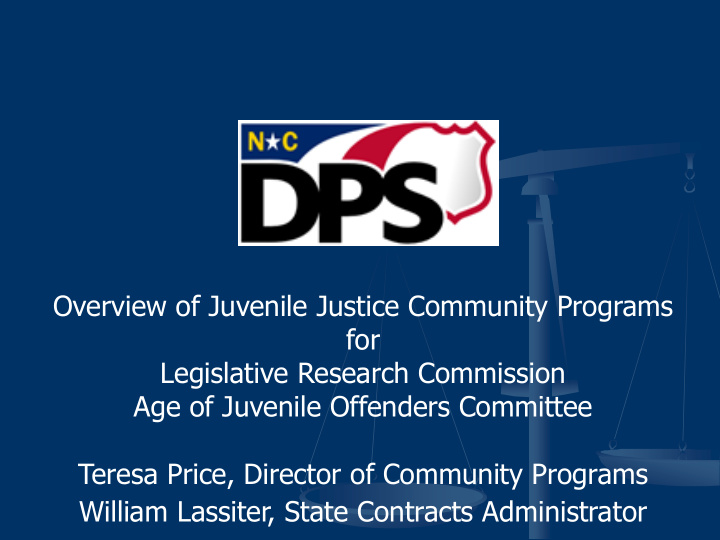



Overview of Juvenile Justice Community Programs for Legislative Research Commission Age of Juvenile Offenders Committee Teresa Price, Director of Community Programs William Lassiter, State Contracts Administrator
Community Programs Overview The Community Programs Section is statutorily mandated to prevent initial or further involvement of youth in the juvenile justice system while contributing to public safety locally. These prevention, intervention, and re-entry programs are evidence-based or research-supported and have been instrumental in the steady decline of juvenile crime over the last decade.
Detention Center Admissions Since 2005, admissions to detention have declined 29%. Juveniles Admissions 9,000 7,839 8,000 7,394 7,234 7,105 7,000 6,604 6,380 6,000 5,357 5,240 5,052 4,875 4,752 5,000 4,342 4,221 4,000 3,522 3,000 2,000 1,000 0 2005 2006 2007 2008 2009 2010 2011 3
Youth Development Center Commitments
Gang Grant Results
2000-2011 Delinquency Rate NC’s juvenile delinquency rate is at an all -time low. 39.00 37.00 36.30 36.21 35.75 35.32 34.86 34.69 34.61 35.00 34.08 33.00 31.52 31.00 29.14 29.00 27.55 27.00 26.08 25.00 2000 2001 2002 2003 2004 2005 2006 2007 2008 2009 2010 2011 * Delinquency rate is defined as delinquent complaints received per 1,000 youth ages 6-15 . 6
Community Programs Overview JCPC Funded Programs JCPC Endorsed Alternatives to Commitment Programs JCPC Endorsed Level II Programs
Community Programs Overview State Residential Contracts Methodist Home for Children (Multipurpose Juvenile Homes) Eckerd Short-Term Residential for Males WestCare Short-Term Residential for Females State Home-Based Contractual Services AMIKids (Functional Family Therapy) Eckerd (Cognitive Behavioral Therapy, Wrap- Around Services and Re-Entry Services)
Overview of Comprehensive Strategy for Juvenile Justice
Juvenile Crime Prevention Councils
Part 6. Juvenile Crime Prevention Councils § 143B-543. Legislative intent. It is the intent of the General Assembly to prevent juveniles who are at risk from becoming delinquent. The primary intent of this Part is to develop community-based alternatives to youth development centers and to provide community-based delinquency, substance abuse, and gang prevention strategies and programs. Additionally, it is the intent of the General Assembly to provide noninstitutional dispositional alternatives that will protect the community and the juveniles.
JCPC-Funded Programs Keeping 1% of those served by JCPC-funded programs out of YDCs represents a cost savings equal to more than the total State budget for JCPCs.
Youth Population and JCPC Allocation Trends: 1999-2011 1,100,000 $25,000,000 1,000,000 $20,000,000 900,000 $15,000,000 800,000 $10,000,000 700,000 $5,000,000 600,000 500,000 $0 10-17 Population JCPC Funding
JCPC Overview 100 county government partnerships 100 JCPCs Over 600 programs Over 1,500 local non-profit and local government employees providing programming Approximately 30,000 youth served annually
JCPC Collaboration
JCPC Program Types Residential Programs Restorative Programs Clinical Treatment Programs Structured Activities
Residential Programs Group Homes Temporary Shelter Care Runaway Shelter Specialized Foster Care Temporary Foster Care
Restorative Programs Teen Court Restorative Intervention Mediation Restitution (Victim Compensation and Community Service)
Clinical Treatment Programs Individual/Group/Family Therapy Home-Based Family Counseling Substance Abuse Treatment Sex Offender Treatment
Structured Activities Structured Day Program Mentoring Parent/Family Skill Building Interpersonal Skill Building Experiential Skill Building Tutoring/Academic Enhancement Vocational Development
Combining State and Local Resources Total DJJ allocation to JCPCs $21,712,707.01 Total resources leveraged through the partnership with State and local entities $37,408,312.00 For every dollar the State allocates for JCPC programs, local communities provide another $0.72 Average cost per youth $1,288.74 Average DJJ cost per youth $748.02
JCPC Endorsed Alternatives to Commitment Programs
JCPC Endorsed Alternatives to Commitment Programs Serve Level III and Level II disposed juveniles Evidence-based services including: CBT, intensive in-home counseling, wrap- around and family-based counseling Cost per juvenile approximately $7,064
JCPC Endorsed Level II Programs
JCPC Endorsed Level II Programs Evidence-Based Programming including: Sex Offender Treatment Trauma-Focused CBT Family Therapy CBT
State Contractual Services
Residential Services
Multipurpose Juvenile Homes Operated by Methodist Home for Children Intense residential services for Level II disposed youth 6 to 8 months Based on the Family Teaching Model 40 beds (approximately 80 annually) Cost per juvenile approximately $39,060
Craven Transitional Home Operated by Methodist Home for Children Youth transitioning from YDC commitment to independent living 6 to 12 months Based on the Family Teaching Model 6 beds (approximately 12 annually) All youth are employed and attending community college
Eckerd Campus at Wilkes and Candor Intense residential services 3 to 6 months Based on CBT (Cognitive Behavioral Therapy) 48 beds (approximately 140 annually) Cost per juvenile approximately $28,767
WestCare Residential Services Intensive female residential service for Level II disposed youth 3 – 6 months Trauma-informed, gender-responsive treatment 16 beds (approximately 35 annually) Cost per juvenile is $45,900
Home-Based Contractual Services
Home-Based Contractual Services Eckerd CBT Wrap-around services Re-entry services Average length of stay 6 months Cost per juvenile approximately $4,320
Home-Based Contractual Services AMIKids Functional Family Therapy Average length of stay 6 months Cost per juvenile approximately $8,640
Provider Coverage Areas for Home-Based Contractual Services Alleghany Northampton Ashe Stokes Gates Surry Person Rockingham Caswell Vance Warren Hertford Halifax Wilkes Watauga Yadki Avery n Forsyth Orange Franklin Bertie Guilford Durham Nash Yance Caldwell Alexander Davie Edgecombe Madison y Tyrrell Martin Iredell Davidson Wake Burke Dare Randolph Chatham Wilson Catawba Buncombe McDowell Rowan Pitt Beaufort Haywood Swain Johnston Hyde Greene Lee Rutherford Cabarrus Harnett Graham Jackson Henderson Stanly Wayne Cleveland Gaston Moore Polk Mecklenburg Lenoir Craven Cherokee Macon Cumberland Clay Richmond Hok Jones Sampson Union Anson e Duplin Carteret Onslow Eckerd Youth Alternatives Robeson Bladen Pender AMIKids New Columbus Hanover Brunswick
Impact of Raising the Age on Community Programming
Community Programming Needs for 16 and 17 Year Olds Vocational programs Sex offender treatment Substance abuse treatment Parenting skills for our target population
Community Programming Needs for 16 and 17 Year Olds Non-traditional education Structured day programs Transitional/re-entry services Gang prevention/intervention Residential placement
Community Programming Needs for 16 and 17 Year Olds Risk management for program personnel Training needs for new target population Separation of younger teens from older youth in residential and community programs
Contact Teresa Price, Director teresa.price@ncdps.gov William Lassiter, State Administrator william.lassiter@ncdps.gov (919) 733-3388
Recommend
More recommend